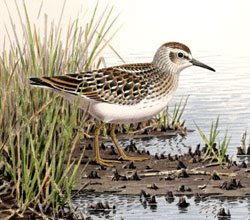Breeding Bird Atlases (BBA)
Find a Bird - BBA1
Breeding Bird Atlas 1 Species Accounts
Least Sandpiper
Calidris minutilla
Egg Dates
not available
Number of Broods
one; may re-lay if first attempt fails.

Although a common migrant in suitable habitat throughout most of Massachusetts, the Least Sandpiper takes its place among the state’s breeding birds on the basis of a single chick, no more than 3 days old, found freshly dead on Monomoy Island on July 12, 1979. The chick was completely downy, smaller than a Ping-Pong ball, white below and dark chestnut brown above, the white-tipped down on the back and crown giving it a spangled appearance. The normal breeding range of the Least Sandpiper stretches from western Alaska across northern (but not high Arctic) Canada east to Newfoundland, with a disjunct population on Sable Island off Nova Scotia and on the Nova Scotia mainland. There is also a recent breeding record from Machias Seal Island in New Brunswick.
As migrants, Least Sandpipers like mudflats, muddy margins of rivers and ponds, and wet agricultural land rather than sandy beaches. Wherever found, Least Sandpipers are the smallest of our peeps and the most mouselike, running about in a crouching posture along the edges of vegetation, often keeping up a constant chittering as they pick at minute organisms. When flushed, they dart off like tiny snipe, uttering a high-pitched threeep note. Compared with other native peeps, they are smaller, darker, browner on both back and breast, and the only ones with yellowish legs. Their spring migration is limited mostly to May, peaking during the second week.
No one has ever reported seeing a displaying Least Sandpiper in Massachusetts. However, working back from July 12, it is reasonable to presume that, sometime during the second week of June 1979, a male Least Sandpiper probably engaged in an early-morning aerial display over the Monomoy mudflats. First flying upward at a steep angle, then leveling off to alternate fluttering with a stiff-winged sailing, a female was attracted to this display, which was accompanied by a song of short, high notes. Later, she laid at least one egg, perhaps the usual four, then possibly flew on north, leaving the male to incubate and rear the young; in this species, most incubation and brood rearing is the male’s responsibility.
The young chick found was on the inner side of North Monomoy Island, on a raised hummock close to a ridge that separates the wet marsh from the waters of Nantucket Sound, in an area dominated by Saltwater Cordgrass and Salt-hay. Given its age, the chick was probably close to the nest.
Breeding sites across Canada are generally in mossy bogs, muskeg, and hummocky sedge meadows but sometimes on drier upland near mudflats or tidal water. On Sable Island, the species nests abundantly in the vicinity of freshwater and brackish ponds, where intensive livestock grazing keeps the vegetation short. The nest is a small depression, lined with a bit of grass and a few dead leaves. The average incubation period is 20 days. The young are precocial and are led away from the vicinity of the nest by the parent soon after hatching. Fledging age has not been recorded.
Fall migration is stretched out over three months, with the bulk of the adults moving through Massachusetts in July and early August, followed by the juveniles in late August and September. The last dawdlers moving north in June almost overlap with the first fall migrants in early July (perhaps non- or failed breeders). Only stragglers are seen in Massachusetts after early October. The species winters as far north as North Carolina on the Atlantic coast but more commonly from Mexico, the West Indies, and Central America into South America.
Map Legend and Data Summary
Atlas 1 data collected from 1975-1979


Note: once at Monomoy National Wildlife Refuge; an extralimital breeder
Kathleen S. Anderson



